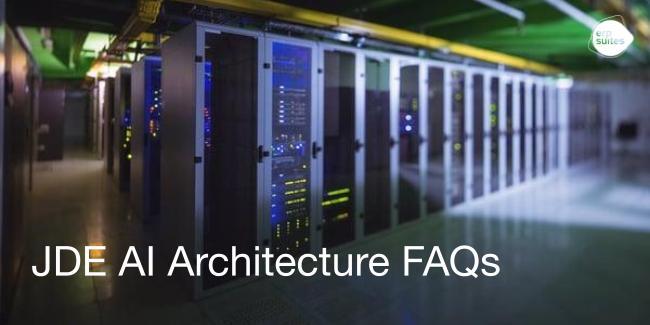What Roadblocks Will You Encounter When Integrating AI with JD Edwards?
January 24th, 2025
5 min read
.png?width=650&height=325&name=Blog%20Images%202_1%20(3).png)
You’re ready to take your JD Edwards environment to the next level with artificial intelligence (AI). You’ve heard about the transformative potential of AI—streamlining operations, predicting trends, and improving decision-making. You’re worried that not adopting AI means you’ll fall behind your competition. You’re worried you can’t afford not to adopt AI.
But you’ve got some questions:
- How do I even start?
- Will my existing system work with AI tools?
- What challenges will I face, and will they derail my efforts?
You’re not alone. Integrating AI into a legacy ERP system like JD Edwards is no small task.
At ERP Suites, we pride ourselves on being on the cutting edge of integrating AI with JD Edwards for our customers. Our AI advisory team members are also JDE experts with years of experience who understand the nuances both technologies require to work together. We have a tested-out financial digital assistant, and have already helped some of our early-adopter customers integrate AI into their daily practice.
You want a partner who believes integrating AI with your JDE is possible. The rewards outweigh the challenges if you do it right.
At the end of this article, you’ll walk away with a clear understanding of the most common roadblocks on your AI + JDE integration journey and how to overcome them.
What Transformations Can You Expect by Adding AI to JD Edwards?
Integrating AI with ERP systems like JD Edwards opens all kinds of new doors. AI’s capabilities partner with the power of your existing JDE for an unstoppable duo. You can use AI tools with your JDE to analyze data, automate tasks, and provide predictive insights.
For example, an AI-powered solution could analyze historical sales data in JD Edwards. These insights can more accurately predict future demand. This subsequently optimizes inventory and reduces waste. AI could also automate tasks like processing invoices or generating reports. Think of all that time you could free up – time your team can use to focus on strategic initiatives.
You’re supercharging JD Edwards with AI capabilities that make your operations smarter, faster, and more efficient. Integration most often looks like connecting AI models directly to JD Edwards or by using external tools and middleware.
Of course, with technology this new and rapidly developing, there are some roadblocks along the way to successful integration – and later implementation. You can expect to encounter:
- Data Integration Challenges
- Skills Gaps
- Security Concerns
- Compatibility Issues
What Data Challenges Will I Face Integrating AI with JD Edwards?
Just like in any other project, your data is essential. Data is the foundation of any AI initiative, but working with data in ERP systems like JDE isn’t always straightforward.
Many organizations struggle with inconsistent formats, siloed systems, and outdated processes. If your data isn’t clean and well-organized, even the smartest AI solution will stumble.
For example, let’s say you’re using JD Edwards to manage inventory in multiple warehouses. However, your data includes inconsistent product codes. You’ve got a product labeled as “Prod001” in one location and “P001” in another. AI won’t be able to make sense of that.
The result? Faulty predictions and frustrated users.
How to Overcome this Roadblock
Start with a robust Extract, Transform, and Load (ETL) process. This means:
- Extracting data from your systems (like JD Edwards or third-party platforms)
- Transforming it into a consistent, standardized format AI can understand
- Loading it into a centralized repository, like an Autonomous Data Warehouse (ADW)
Tools like OCI GoldenGate and OCI Data Integrator can help streamline this process. These tools replicate data in real time and ensure it’s clean and ready for AI processing. Think of them as the conveyor belts in a factory—moving data efficiently to where it needs to go.
Additionally, investing in data mapping and transformation capabilities helps efficiently channel JD Edwards data into the AI services and models of your choice.
Do I Have the Right In-House Expertise for Integrating AI with JD Edwards?
AI is complex. Most JD Edwards teams don’t have daily experience with AI. In fact, most ERP system teams in general aren’t fully versed in AI practices. JD Edwards was built for tasks like managing financials and manufacturing, not predictive analytics or machine learning. This means your team might lack the skills to implement AI effectively.
For instance, say you’re a furniture manufacturer. You want to use AI to forecast inventory needs before the holiday season. But first you’ll need a clear understanding of AI models and how to deploy them. Maybe you want to use a financial digital assistant to predict costs and potential revenue. But if your team doesn’t have the necessary expertise, you might struggle to bring your AI and JDE together.
How to Overcome this Roadblock
- Train Your Team: Invest in training programs tailored to AI and JD Edwards integration. Many online platforms offer courses, but make sure they’re relevant to your industry and tools.
- Hire Specialists: Bring in data scientists or AI consultants to guide your efforts. This might feel like a big investment upfront, but it can save you time and resources in the long run.
- Start Small: Begin with simple AI applications, like automating routine tasks. This builds confidence and allows your team to grow their skills incrementally.
Think of it like learning a new software program. You wouldn’t expect to master something like Photoshop overnight. You’d start with basic tasks like cropping images and gradually learn more advanced features. AI is similar. Starting small sets you up for long-term success.
What Security Challenges Will I Face Integrating AI with JD Edwards?
AI systems are inherently vulnerable because they rely so heavily on data. Moving data between JD Edwards and AI platforms creates potential entry points for malicious actors. AI models themselves can also be maliciously manipulated.
Data encryption is one of the most common vulnerabilities. Data needs to be secure both when it’s at rest (in storage) and in transit (being moved between systems. Access to data itself is also a point of vulnerability. Robust Identity and Access Management (IAM) means controlling who has access to what, when.
Security weaknesses could also mean your business falls out of compliance with industry regulations. Healthcare companies need to adhere to HIPAA guidelines. Customer or user data is protected by GDPR rules.
How to Overcome this Roadblock
- Implement IAM roles to define who can access certain data and AI tools. For instance, only finance team members should access financial AI models.
- Use data masking to hide sensitive information, like Social Security numbers or credit card details, from unauthorized users.
- Employ auditing and logging to track data usage and identify potential breaches.
Think of it like adding locks to your doors and setting up a home security system. You’re creating multiple layers of protection to keep your data safe.
What Compatibility Issues Will I Face When Integrating AI with JD Edwards?
JD Edwards has been around for decades. Many businesses are running older versions that lack modern capabilities. If you’re not on the latest tools release, like 9.2.4 and beyond, it can be harder to integrate AI solutions.
That’s because newer JD Edwards releases now include orchestrations. These features make it possible to connect JD Edwards with external systems like AI platforms. Without these, integration requires more custom coding and workarounds.
How to Overcome This Roadblock
- Upgrade Your Tools Release: Moving to the latest version unlocks features like orchestrations and better integration capabilities.
- Explore Middleware Solutions: If upgrading isn’t feasible, middleware tools can bridge the gap. These tools act as translators, helping older systems communicate with newer AI technologies.
What Are My Next Steps to Make Integrating AI with JD Edwards Possible?
Integrating AI with JD Edwards can seem intimidating because it does require planning and precision to work effectively. But it doesn’t have to be.
By addressing data integration, closing the skills gap, prioritizing security, and upgrading systems, you can set your business up for success.
The goal isn’t to jump on the AI bandwagon just because it’s trendy. You need a plan for leveraging AI to solve real business problems and unlock new opportunities. Whether you’re interested in starting to automate your warehouse or offload repetitive tasks, there is an AI solution for your needs.
See how ERP Suites recently helped a customer successfully integrate AI with JD Edwards.
Leyla Shokoohe is an award-winning journalist with over a decade of experience, specializing in workplace and journalistic storytelling and marketing. As content manager at ERP Suites, she writes articles that help customers understand every step of their individual ERP journey.



.png?width=650&height=325&name=Blog%20Images%202_1%20(4).png)
.png?width=650&height=325&name=Blog%20Images%202_1%20(5).png)
.png?width=650&height=325&name=Blog%20Images%202_1%20(2).png)
.png?width=650&height=325&name=Blog%20Images%202_1%20(1).png)
.png?width=960&height=540&name=Blog%20Images%20(96).png)

.png?width=960&height=540&name=Blog%20Images%20(90).png)
.png?width=960&height=540&name=Blog%20Images%20(88).png)
.png?width=960&height=540&name=Blog%20Images%20(87).png)
.png?width=960&height=540&name=Blog%20Images%20(86).png)
.png?width=960&height=540&name=Blog%20Images%20(85).png)
.png?width=960&height=540&name=Blog%20Images%20(83).png)
.png?width=960&height=540&name=Blog%20Images%20(82).png)
.png?width=960&height=540&name=Blog%20Images%20(80).png)
.png?width=960&height=540&name=Blog%20Images%20(79).png)
.png?width=960&height=540&name=Blog%20Images%20(78).png)
.png?width=960&height=540&name=Blog%20Images%20(77).png)